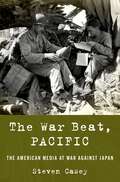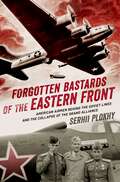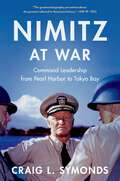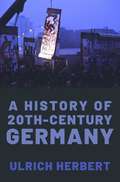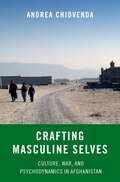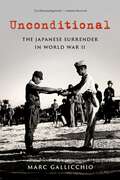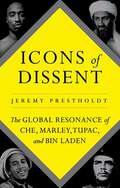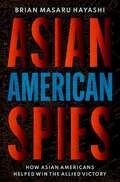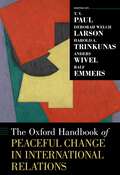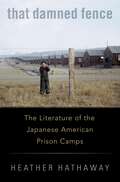- Table View
- List View
The War Beat, Pacific: The American Media at War Against Japan
by Steven CaseyThe definitive history of American war reporting in the Pacific theater of World War II, from the attack on Pearl Harbor to the atomic bombings of Hiroshima and Nagasaki. After almost two years slogging with infantrymen through North Africa, Italy, and France, Ernie Pyle immediately realized he was ill-prepared for covering the Pacific War. As Pyle and other war correspondents discovered, the climate, the logistics, and the sheer scope of the Pacific theater had no parallel in the war America was fighting in Europe. From Pearl Harbor to Hiroshima and Nagasaki, The War Beat, Pacific provides the first comprehensive account of how a group of highly courageous correspondents covered America's war against Japan, what they witnessed, what they were allowed to publish, and how their reports shaped the home front's perception of some of the most pivotal battles in American military history. In a dramatic and fast-paced narrative based on a wealth of previously untapped primary sources, Casey takes us from MacArthur's doomed defense on the Philippines and the navy's overly strict censorship policy at the time of Midway, through the bloody battles on Guadalcanal, New Guinea, Tarawa, Saipan, Leyte and Luzon, Iwo Jima and Okinawa, detailing the cooperation, as well as conflict, between the media and the military, as they grappled with the enduring problem of limiting a free press during a period of extreme crisis. The War Beat, Pacific shows how foreign correspondents ran up against practical challenges and risked their lives to get stories in a theater that was far more challenging than the war against Nazi Germany, while the US government blocked news of the war against Japan and tried to focus the home front on Hitler and his atrocities.
The War Beat, Pacific: The American Media at War Against Japan
by Steven CaseyThe definitive history of American war reporting in the Pacific theater of World War II, from the attack on Pearl Harbor to the atomic bombings of Hiroshima and Nagasaki. After almost two years slogging with infantrymen through North Africa, Italy, and France, Ernie Pyle immediately realized he was ill-prepared for covering the Pacific War. As Pyle and other war correspondents discovered, the climate, the logistics, and the sheer scope of the Pacific theater had no parallel in the war America was fighting in Europe. From Pearl Harbor to Hiroshima and Nagasaki, The War Beat, Pacific provides the first comprehensive account of how a group of highly courageous correspondents covered America's war against Japan, what they witnessed, what they were allowed to publish, and how their reports shaped the home front's perception of some of the most pivotal battles in American military history. In a dramatic and fast-paced narrative based on a wealth of previously untapped primary sources, Casey takes us from MacArthur's doomed defense on the Philippines and the navy's overly strict censorship policy at the time of Midway, through the bloody battles on Guadalcanal, New Guinea, Tarawa, Saipan, Leyte and Luzon, Iwo Jima and Okinawa, detailing the cooperation, as well as conflict, between the media and the military, as they grappled with the enduring problem of limiting a free press during a period of extreme crisis. The War Beat, Pacific shows how foreign correspondents ran up against practical challenges and risked their lives to get stories in a theater that was far more challenging than the war against Nazi Germany, while the US government blocked news of the war against Japan and tried to focus the home front on Hitler and his atrocities.
Military Medicine and the Hidden Costs of War (Bridging the Gap)
by Tanisha M. FazalA highly original comprehensive history of US military medicine. Decisions to go to war are often framed in cost-benefit terms, and typically such assessments do not factor in longer term costs. However, recent dramatic improvements in American military medicine have had an unanticipated effect: saving more soldiers' lives has vastly increased long-term, downstream costs of war with profound consequences for global politics in an era of heightened great power competition. In Military Medicine and the Hidden Costs of War, Tanisha M. Fazal traces the modern history of medical treatment and casualty rates in American conflicts from the Civil War to the more recent counterinsurgency wars. As she shows, wars became increasingly survivable for wounded troops, to the point now where a large majority of wounded soldiers survive. Yet the human and financial implications of this steep increase in the wounded-to-killed ratio are dramatic, and her powerful analysis of this shift provides a necessary corrective to how we understand the costs of war. For each major conflict, Fazal analyzes the weapons used, injuries sustained, and policies put in place for veterans' care and pensions. As she argues, these improvements have significant financial and deeply personal implications for the returned wounded and their families, as well as the US government and its citizenry. Fazal's analysis highlights the significance of policymakers underestimating the costs of war, which in turn makes it easier both to initiate and continue military action abroad, contributing to Americas' penchant for engaging in so-called "endless wars." A sweeping political history, Military Medicine and the Hidden Costs of War will fundamentally change our understanding of the lasting consequences of America's wars.
Military Medicine and the Hidden Costs of War (Bridging the Gap)
by Tanisha M. FazalA highly original comprehensive history of US military medicine. Decisions to go to war are often framed in cost-benefit terms, and typically such assessments do not factor in longer term costs. However, recent dramatic improvements in American military medicine have had an unanticipated effect: saving more soldiers' lives has vastly increased long-term, downstream costs of war with profound consequences for global politics in an era of heightened great power competition. In Military Medicine and the Hidden Costs of War, Tanisha M. Fazal traces the modern history of medical treatment and casualty rates in American conflicts from the Civil War to the more recent counterinsurgency wars. As she shows, wars became increasingly survivable for wounded troops, to the point now where a large majority of wounded soldiers survive. Yet the human and financial implications of this steep increase in the wounded-to-killed ratio are dramatic, and her powerful analysis of this shift provides a necessary corrective to how we understand the costs of war. For each major conflict, Fazal analyzes the weapons used, injuries sustained, and policies put in place for veterans' care and pensions. As she argues, these improvements have significant financial and deeply personal implications for the returned wounded and their families, as well as the US government and its citizenry. Fazal's analysis highlights the significance of policymakers underestimating the costs of war, which in turn makes it easier both to initiate and continue military action abroad, contributing to Americas' penchant for engaging in so-called "endless wars." A sweeping political history, Military Medicine and the Hidden Costs of War will fundamentally change our understanding of the lasting consequences of America's wars.
Forgotten Bastards of the Eastern Front: American Airmen behind the Soviet Lines and the Collapse of the Grand Alliance
by Serhii PlokhyThe full story of the first and only time American and Soviets fought side-by-side in World War II At the conference held in in Moscow in October 1943, American officials proposed to their Soviet allies a new operation in the effort to defeat Nazi Germany. The Normandy Invasion was already in the works; what American officials were suggesting until then was a second air front: the US Air Force would establish bases in Soviet-controlled territory, in order to "shuttle-bomb" the Germans from the Eastern front. For all that he had been pushing for the United States and Great Britain to do more to help the war effort--the Soviets were bearing by far the heaviest burden in terms of casualties--Stalin, recalling the presence of foreign troops during the Russian Revolution, balked at the suggestion of foreign soldiers on Soviet soil. His concern was that they would spy on his regime, and it would be difficult to get rid of them afterword. Eventually in early 1944, Stalin was persuaded to give in, and Operation Baseball and then Frantic were initiated. B-17 Flying Fortresses were flown from bases in Italy to the Poltava region in Ukraine. As Plokhy's book shows, what happened on these airbases mirrors the nature of the Grand Alliance itself. While both sides were fighting for the same goal, Germany's unconditional surrender, differences arose that no common purpose could overcome. Soviet secret policeman watched over the operations, shadowing every move, and eventually trying to prevent fraternization between American servicemen and local women. A catastrophic air raid by the Germans revealed the limitations of Soviet air defenses. Relations soured and the operations went south. Indeed, the story of the American bases foreshadowed the eventual collapse of the Grand Alliance and the start of the Cold War. Using previously inaccessible archives, Forgotten Bastards offers a bottom-up history of the Grand Alliance, showing how it first began to fray on the airfields of World War II.
Forgotten Bastards of the Eastern Front: American Airmen behind the Soviet Lines and the Collapse of the Grand Alliance
by Serhii PlokhyThe full story of the first and only time American and Soviets fought side-by-side in World War II At the conference held in in Moscow in October 1943, American officials proposed to their Soviet allies a new operation in the effort to defeat Nazi Germany. The Normandy Invasion was already in the works; what American officials were suggesting until then was a second air front: the US Air Force would establish bases in Soviet-controlled territory, in order to "shuttle-bomb" the Germans from the Eastern front. For all that he had been pushing for the United States and Great Britain to do more to help the war effort--the Soviets were bearing by far the heaviest burden in terms of casualties--Stalin, recalling the presence of foreign troops during the Russian Revolution, balked at the suggestion of foreign soldiers on Soviet soil. His concern was that they would spy on his regime, and it would be difficult to get rid of them afterword. Eventually in early 1944, Stalin was persuaded to give in, and Operation Baseball and then Frantic were initiated. B-17 Flying Fortresses were flown from bases in Italy to the Poltava region in Ukraine. As Plokhy's book shows, what happened on these airbases mirrors the nature of the Grand Alliance itself. While both sides were fighting for the same goal, Germany's unconditional surrender, differences arose that no common purpose could overcome. Soviet secret policeman watched over the operations, shadowing every move, and eventually trying to prevent fraternization between American servicemen and local women. A catastrophic air raid by the Germans revealed the limitations of Soviet air defenses. Relations soured and the operations went south. Indeed, the story of the American bases foreshadowed the eventual collapse of the Grand Alliance and the start of the Cold War. Using previously inaccessible archives, Forgotten Bastards offers a bottom-up history of the Grand Alliance, showing how it first began to fray on the airfields of World War II.
Nimitz at War: Command Leadership from Pearl Harbor to Tokyo Bay
by Craig L. SymondsFrom America's preeminent naval historian, the first full-length portrait in over fifty years of the man who won the war in the Pacific in World War Two"destined," says Andrew Roberts, "to be the defining life of Chester Nimitz for a long time to come." Only days after the Japanese attacked Pearl Harbor, President Franklin D. Roosevelt tapped Chester W. Nimitz to assume command of the Pacific Fleet. Nimitz was not the most senior candidate available, and some, including his new boss, U.S. Navy Admiral Ernest J. King, considered him a "desk admiral," more suited to running a bureaucracy than a theater of war. Yet FDR's selection proved nothing less than inspired. From the precarious early months of the war after December 7th 1941 to the surrender ceremony in Tokyo Bay nearly four years later, Nimitz transformed the devastated and dispirited Pacific fleet into the most powerful and commanding naval force in history. From the start, the pressures on Nimitz were crushing. Facing demands from Washington to mount an early offensive, he had first to revive the depressed morale of the thousands of sailors, soldiers, and Marines who served under him. He had to corral independent-minded subordinatesincluding Admiral Bill "Bull" Halsey and General Holland "Howlin' Mad" Smithand keep them focused on shared objectives. He had to maintain a sometimes-fraught relationship with his Army counterpart Douglas MacArthur, and cope with his superiors, including the formidably prickly King and the inscrutable FDR. He had to navigate the expectations of a nation impatient for revenge and eventual victory. And of course, he also confronted a formidable and implacable enemy in the Imperial Japanese Navy, which, until the Battle of Midway, had the run of the Pacific. Craig Symonds' Nimitz at War reveals how the quiet man from the Hill Country of Texas eventually surmounted all of these challenges. Using Nimitz's headquartersthe eye of the hurricaneas his vantage point, Symonds covers all the major campaigns in the Pacific from Guadalcanal to Okinawa. He captures Nimitz's composure, discipline, homespun wisdom, and most of all his uncanny sense of when to assert authority and when to pull back. In retrospect it is difficult to imagine anyone else accomplishing what Nimitz did. As Symonds' absorbing, dynamic, and authoritative portrait reveals, it required qualities of leadership exhibited by few other commanders in history, qualities that are enduringly and even poignantly relevant to our own moment.Â
Nimitz at War: Command Leadership from Pearl Harbor to Tokyo Bay
by Craig L. SymondsFrom America's preeminent naval historian, the first full-length portrait in over fifty years of the man who won the war in the Pacific in World War Two"destined," says Andrew Roberts, "to be the defining life of Chester Nimitz for a long time to come." Only days after the Japanese attacked Pearl Harbor, President Franklin D. Roosevelt tapped Chester W. Nimitz to assume command of the Pacific Fleet. Nimitz was not the most senior candidate available, and some, including his new boss, U.S. Navy Admiral Ernest J. King, considered him a "desk admiral," more suited to running a bureaucracy than a theater of war. Yet FDR's selection proved nothing less than inspired. From the precarious early months of the war after December 7th 1941 to the surrender ceremony in Tokyo Bay nearly four years later, Nimitz transformed the devastated and dispirited Pacific fleet into the most powerful and commanding naval force in history. From the start, the pressures on Nimitz were crushing. Facing demands from Washington to mount an early offensive, he had first to revive the depressed morale of the thousands of sailors, soldiers, and Marines who served under him. He had to corral independent-minded subordinatesincluding Admiral Bill "Bull" Halsey and General Holland "Howlin' Mad" Smithand keep them focused on shared objectives. He had to maintain a sometimes-fraught relationship with his Army counterpart Douglas MacArthur, and cope with his superiors, including the formidably prickly King and the inscrutable FDR. He had to navigate the expectations of a nation impatient for revenge and eventual victory. And of course, he also confronted a formidable and implacable enemy in the Imperial Japanese Navy, which, until the Battle of Midway, had the run of the Pacific. Craig Symonds' Nimitz at War reveals how the quiet man from the Hill Country of Texas eventually surmounted all of these challenges. Using Nimitz's headquartersthe eye of the hurricaneas his vantage point, Symonds covers all the major campaigns in the Pacific from Guadalcanal to Okinawa. He captures Nimitz's composure, discipline, homespun wisdom, and most of all his uncanny sense of when to assert authority and when to pull back. In retrospect it is difficult to imagine anyone else accomplishing what Nimitz did. As Symonds' absorbing, dynamic, and authoritative portrait reveals, it required qualities of leadership exhibited by few other commanders in history, qualities that are enduringly and even poignantly relevant to our own moment.Â
A History of Twentieth-Century Germany
by Ulrich HerbertGermany in the 20th century endured two world wars, a failed democracy, Hitler's dictatorship, the Holocaust, and a country divided for 40 years after World War II. But it has also boasted a strong welfare state, affluence, liberalization and globalization, a successful democracy, and the longest period of peace in European history. A History of Twentieth-Century Germany provides a survey of German history during a century of extremes. Ulrich Herbert sees German history in the 20th century as determined by two contradictory perspectives. On one hand, there are the world wars and great catastrophes that divide the country's history into two parts-before and after 1945. Germany is the birthplace of radical ideologies of the left and right and the only country in which each ideology became the foundation of government. This pattern left its stamp on both the first and second halves of the century. On the other hand, the rise of modern industrial society led to decades of conflict over the social and political order regardless of which political system was in force. Considering these contradictory developments, Herbert tackles the questions of both the collapse in the first half of the century and the development from a post-fascist, ruined society to one of the most stable liberal democracies in the world in the latter half. Herbert's analysis brings together wars and terror, utopia and politics, capitalism and the welfare state, socialism and liberal democratic society, gender and generations, culture and lifestyles, European integration and globalization. The resulting book sets a standard by which historians of the period will be measured in the future.
A History of Twentieth-Century Germany
by Ulrich HerbertGermany in the 20th century endured two world wars, a failed democracy, Hitler's dictatorship, the Holocaust, and a country divided for 40 years after World War II. But it has also boasted a strong welfare state, affluence, liberalization and globalization, a successful democracy, and the longest period of peace in European history. A History of Twentieth-Century Germany provides a survey of German history during a century of extremes. Ulrich Herbert sees German history in the 20th century as determined by two contradictory perspectives. On one hand, there are the world wars and great catastrophes that divide the country's history into two parts-before and after 1945. Germany is the birthplace of radical ideologies of the left and right and the only country in which each ideology became the foundation of government. This pattern left its stamp on both the first and second halves of the century. On the other hand, the rise of modern industrial society led to decades of conflict over the social and political order regardless of which political system was in force. Considering these contradictory developments, Herbert tackles the questions of both the collapse in the first half of the century and the development from a post-fascist, ruined society to one of the most stable liberal democracies in the world in the latter half. Herbert's analysis brings together wars and terror, utopia and politics, capitalism and the welfare state, socialism and liberal democratic society, gender and generations, culture and lifestyles, European integration and globalization. The resulting book sets a standard by which historians of the period will be measured in the future.
Crafting Masculine Selves: Culture, War, and Psychodynamics in Afghanistan
by Andrea ChiovendaAgainst the backdrop of four decades of continuous conflict in Afghanistan, the Pashtun male protagonists of this book carry out their daily effort to internally negotiate, adjust (if at all), and respond to the very strict cultural norms and rules of masculinity that their androcentric social environment enjoins on them. Yet, in a widespread context of war, displacement, relocation, and social violence, cultural expectations and stringent tenets on how to comport oneself as a "real man" have a profound impact on the psychological equilibrium and emotional dynamics of these individuals. This book is a close investigation into these private and at times contradictory aspects of subjectivity. Stemming from five years of research in a southeastern province of Afghanistan, it presents a long-term, psychodynamic engagement with a select group of male Pashtun individuals, which results in a multilayered dive not only into their inner lives, but also into the cultural and social environment in which they live and develop. Behind the screen of what often seems like outward conformity, Andrea Chiovenda is able to point to areas of strong inner conflict, ambivalence, and rebellion, which in turn will serve as the seeds for cultural and social change. These dynamics play out in a setting in which what was considered legitimate and justifiable violence on the battlefield has now spilled over into everyday life, even among non-combatants.
Crafting Masculine Selves: Culture, War, and Psychodynamics in Afghanistan
by Andrea ChiovendaAgainst the backdrop of four decades of continuous conflict in Afghanistan, the Pashtun male protagonists of this book carry out their daily effort to internally negotiate, adjust (if at all), and respond to the very strict cultural norms and rules of masculinity that their androcentric social environment enjoins on them. Yet, in a widespread context of war, displacement, relocation, and social violence, cultural expectations and stringent tenets on how to comport oneself as a "real man" have a profound impact on the psychological equilibrium and emotional dynamics of these individuals. This book is a close investigation into these private and at times contradictory aspects of subjectivity. Stemming from five years of research in a southeastern province of Afghanistan, it presents a long-term, psychodynamic engagement with a select group of male Pashtun individuals, which results in a multilayered dive not only into their inner lives, but also into the cultural and social environment in which they live and develop. Behind the screen of what often seems like outward conformity, Andrea Chiovenda is able to point to areas of strong inner conflict, ambivalence, and rebellion, which in turn will serve as the seeds for cultural and social change. These dynamics play out in a setting in which what was considered legitimate and justifiable violence on the battlefield has now spilled over into everyday life, even among non-combatants.
God Save the USSR: Soviet Muslims and the Second World War
by Jeff EdenDuring the Second World War, as the Soviet Red Army was locked in brutal combat against the Nazis, Joseph Stalin ended the state's violent, decades-long persecution of religion. In a stunning reversal, priests, imams, rabbis, and other religious elites--many of them newly-released from the Gulag--were tasked with rallying Soviet citizens to a "Holy War" against Hitler. To the delight of some citizens, and to the horror of others, Stalin's reversal encouraged a widespread perception that his "war on religion" was over. A revolution in Soviet religious life ensued: soldiers prayed on the battlefield, entire villages celebrated once-banned holidays, and state-backed religious leaders used their new positions not only to consolidate power over their communities, but also to petition for further religious freedoms. Offering a window on this wartime "religious revolution," God Save the USSR focuses on the Soviet Union's Muslims, using sources in several languages (including Russian, Tatar, Bashkir, Uzbek, and Persian). Drawing evidence from eyewitness accounts, interviews, soldiers' letters, frontline poetry, agents' reports, petitions, and the words of Soviet Muslim leaders, Jeff Eden argues that the religious revolution was fomented simultaneously by the state and by religious Soviet citizens: the state gave an inch, and many citizens took a mile, as atheist Soviet agents looked on in exasperation at the resurgence of unconcealed devotional life.
God Save the USSR: Soviet Muslims and the Second World War
by Jeff EdenDuring the Second World War, as the Soviet Red Army was locked in brutal combat against the Nazis, Joseph Stalin ended the state's violent, decades-long persecution of religion. In a stunning reversal, priests, imams, rabbis, and other religious elites--many of them newly-released from the Gulag--were tasked with rallying Soviet citizens to a "Holy War" against Hitler. To the delight of some citizens, and to the horror of others, Stalin's reversal encouraged a widespread perception that his "war on religion" was over. A revolution in Soviet religious life ensued: soldiers prayed on the battlefield, entire villages celebrated once-banned holidays, and state-backed religious leaders used their new positions not only to consolidate power over their communities, but also to petition for further religious freedoms. Offering a window on this wartime "religious revolution," God Save the USSR focuses on the Soviet Union's Muslims, using sources in several languages (including Russian, Tatar, Bashkir, Uzbek, and Persian). Drawing evidence from eyewitness accounts, interviews, soldiers' letters, frontline poetry, agents' reports, petitions, and the words of Soviet Muslim leaders, Jeff Eden argues that the religious revolution was fomented simultaneously by the state and by religious Soviet citizens: the state gave an inch, and many citizens took a mile, as atheist Soviet agents looked on in exasperation at the resurgence of unconcealed devotional life.
Mercy: Humanity in War
by Cathal J. NolanWar presents the most degraded moral environment humanity creates. It is an arena where individuality is subsumed in collective violence and humanity is obscured as a faceless, merciless enemy pitted against its reflection in an elemental struggle for survival. A barbaric logic has guided the conduct of war throughout history. Yet as Cathal Nolan reveals in this gripping, poignant, and powerful book, even as war can obliterate hope and decency at the grand level it simultaneously produces conditions that permit astonishing exceptions of mercy and shared dignity. Pulling the trigger is usually both the expedient thing and required by war's grim and remorseless calculus. Yet somehow the trigger is not always pulled. A different choice is made. Restraint triumphs. Humanity is rediscovered and honored in a flash of recognition. This book gathers and explores acts of singular mercy, giving them form and substanceacross wars, causes, and opposing uniforms. These acts demand our attention not only for the moral uplift they supply but because they challenge assumptions about humanity itself. Rising above ordinary courage, they may ultimately transcend our understanding, entering the realm of the ineffable. Nevertheless, as Nolan shows, acts of mercy in war are not the provenance of saints but of ordinary men and women who perform them at great personal risk. As much or more than the normal war hero stories, we must recognize the extraordinary courage of the merciful in war. Mercy is an exceptional book about exceptions, challenging myths and heroic fabrications, refuting claims to exclusive moral virtue. It reminds us that decency in warfare is also universal, offering a haunting and compellingly humane counternarrative to war's usual inhumane logic.
Mercy: Humanity in War
by Cathal J. NolanWar presents the most degraded moral environment humanity creates. It is an arena where individuality is subsumed in collective violence and humanity is obscured as a faceless, merciless enemy pitted against its reflection in an elemental struggle for survival. A barbaric logic has guided the conduct of war throughout history. Yet as Cathal Nolan reveals in this gripping, poignant, and powerful book, even as war can obliterate hope and decency at the grand level it simultaneously produces conditions that permit astonishing exceptions of mercy and shared dignity. Pulling the trigger is usually both the expedient thing and required by war's grim and remorseless calculus. Yet somehow the trigger is not always pulled. A different choice is made. Restraint triumphs. Humanity is rediscovered and honored in a flash of recognition. This book gathers and explores acts of singular mercy, giving them form and substanceacross wars, causes, and opposing uniforms. These acts demand our attention not only for the moral uplift they supply but because they challenge assumptions about humanity itself. Rising above ordinary courage, they may ultimately transcend our understanding, entering the realm of the ineffable. Nevertheless, as Nolan shows, acts of mercy in war are not the provenance of saints but of ordinary men and women who perform them at great personal risk. As much or more than the normal war hero stories, we must recognize the extraordinary courage of the merciful in war. Mercy is an exceptional book about exceptions, challenging myths and heroic fabrications, refuting claims to exclusive moral virtue. It reminds us that decency in warfare is also universal, offering a haunting and compellingly humane counternarrative to war's usual inhumane logic.
Unconditional: The Japanese Surrender in World War II (Pivotal Moments in American History)
by Marc GallicchioA new look at the drama that lay behind the end of the war in the Pacific Signed on September 2, 1945 aboard the American battleship USS Missouri in Tokyo Bay by Japanese and Allied leaders, the instrument of surrender that formally ended the war in the Pacific brought to a close one of the most cataclysmic engagements in history. Behind it lay a debate that had been raging for some weeks prior among American military and political leaders. The surrender fulfilled the commitment that Franklin Roosevelt had made in 1943 at the Casablanca conference that it be "unconditional." Though readily accepted as policy at the time, after Roosevelt's death in April 1945 support for unconditional surrender wavered, particularly among Republicans in Congress, when the bloody campaigns on Iwo Jima and Okinawa made clear the cost of military victory against Japan. Germany's unconditional surrender in May 1945 had been one thing; the war in the pacific was another. Many conservatives favored a negotiated surrender. Though this was the last time American forces would impose surrender unconditionally, questions surrounding it continued through the 1950s and 1960s--with the Korean and Vietnam Wars--when liberal and conservative views reversed, including over the definition of "peace with honor." The subject was revived during the ceremonies surrounding the 50th anniversary in 1995, and the Gulf and Iraq Wars, when the subjects of exit strategies and "accomplished missions" were debated. Marc Gallicchio reveals how and why the surrender in Tokyo Bay unfolded as it did and the principle figures behind it, including George C. Marshall and Douglas MacArthur. The latter would effectively become the leader of Japan and his tenure, and indeed the very nature of the American occupation, was shaped by the nature of the surrender. Most importantly, Gallicchio reveals how the policy of unconditional surrender has shaped our memory and our understanding of World War II.
Unconditional: The Japanese Surrender in World War II (Pivotal Moments in American History)
by Marc GallicchioA new look at the drama that lay behind the end of the war in the Pacific Signed on September 2, 1945 aboard the American battleship USS Missouri in Tokyo Bay by Japanese and Allied leaders, the instrument of surrender that formally ended the war in the Pacific brought to a close one of the most cataclysmic engagements in history. Behind it lay a debate that had been raging for some weeks prior among American military and political leaders. The surrender fulfilled the commitment that Franklin Roosevelt had made in 1943 at the Casablanca conference that it be "unconditional." Though readily accepted as policy at the time, after Roosevelt's death in April 1945 support for unconditional surrender wavered, particularly among Republicans in Congress, when the bloody campaigns on Iwo Jima and Okinawa made clear the cost of military victory against Japan. Germany's unconditional surrender in May 1945 had been one thing; the war in the pacific was another. Many conservatives favored a negotiated surrender. Though this was the last time American forces would impose surrender unconditionally, questions surrounding it continued through the 1950s and 1960s--with the Korean and Vietnam Wars--when liberal and conservative views reversed, including over the definition of "peace with honor." The subject was revived during the ceremonies surrounding the 50th anniversary in 1995, and the Gulf and Iraq Wars, when the subjects of exit strategies and "accomplished missions" were debated. Marc Gallicchio reveals how and why the surrender in Tokyo Bay unfolded as it did and the principle figures behind it, including George C. Marshall and Douglas MacArthur. The latter would effectively become the leader of Japan and his tenure, and indeed the very nature of the American occupation, was shaped by the nature of the surrender. Most importantly, Gallicchio reveals how the policy of unconditional surrender has shaped our memory and our understanding of World War II.
Icons of Dissent: The Global Resonance of Che, Marley, Tupac and Bin Laden
by Jeremy PrestholdtThe global icon is an omnipresent but poorly understood element of mass culture. This book asks why audiences around the world have embraced particular iconic figures, how perceptions of these figures have changed, and what this tells us about transnational relations since the Cold War era. Prestholdt addresses these questions by examining one type of icon: the anti-establishment figure. As symbols that represent sentiments, ideals, or something else recognizable to a wide audience, icons of dissent have been integrated into diverse political and consumer cultures, and global audiences have reinterpreted them over time. To illustrate these points the book examines four of the most evocative and controversial figures of the past fifty years: Che Guevara, Bob Marley, Tupac Shakur, and Osama bin Laden. Each has embodied a convergence of dissent, cultural politics, and consumerism, yet popular perceptions of each reveal the dissonance between shared, global references and locally contingent interpretations. By examining four very different figures, Icons of Dissent offers new insights into global symbolic idioms, the mutability of common references, and the commodification of political sentiment in the contemporary world.
Asian American Spies: How Asian Americans Helped Win the Allied Victory
by Brian Masaru HayashiA recovery of the vital role Chinese, Japanese, and Korean Americans played in US intelligence services in Asia during World War II. Spies deep behind enemy lines; double agents; a Chinese American James Bond; black propaganda radio broadcasters; guerrilla fighters; pirates; smugglers; prostitutes and dancers as spies; and Asian Americans collaborating with Axis Powers. All these colorful individuals form the story of Asian Americans in the Office of Strategic Services (OSS), the forerunner of today's CIA. Brian Masaru Hayashi brings to light for the first time the role played by Chinese, Japanese, and Korean Americans in America's first centralized intelligence agency in its fight against the Imperial Japanese forces in east Asia during World War II. They served deep behind enemy lines gathering intelligence for American and Chinese troops locked in a desperate struggle against Imperial Japanese forces on the Asian continent. Other Asian Americans produced and disseminated statements by bogus peace groups inside the Japanese empire to weaken the fighting resolve of the Japanese. Still others served with guerrilla forces attacking enemy supply and communication lines behind enemy lines. Engaged in this deadly conflict, these Asian Americans agents encountered pirates, smugglers, prostitutes, and dancers serving as the enemy's spies, all the while being subverted from within the OSS by a double agent and without by co-ethnic collaborators in wartime Shanghai. Drawing on recently declassified documents, Asian American Spies challenges the romanticized and stereotyped image of these Chinese, Japanese, and Korean American agents--the Model Minority-while offering a fresh perspective on the Allied victory in the Pacific Theater of World War II.
The Oxford Handbook of Peaceful Change in International Relations (Oxford Handbooks)
The discipline of international relations offers much insight into why violent power transitions occur, yet there have been few substantive examinations of why and how peaceful changes happen in world politics. This work is the first comprehensive treatment of that subject. The Oxford Handbook of Peaceful Change in International Relations provides a thorough examination of research on the problem of change in the international arena and the reasons why change happens peacefully at times, and at others, violently. It contains over forty chapters, which examine the historical, theoretical, global, regional, and national foreign-policy dimensions of peaceful change. As the world enters a new round of power transition conflict, involving a rapidly rising China and a relatively declining United States, this Handbook provides a necessary resource for decisionmakers and scholars engaged in this vital area of research.
The Oxford Handbook of Peaceful Change in International Relations (Oxford Handbooks)
by T. V. Paul Deborah Welch Larson Harold A. Trinkunas Ralf Emmers Anders WivelThe discipline of international relations offers much insight into why violent power transitions occur, yet there have been few substantive examinations of why and how peaceful changes happen in world politics. This work is the first comprehensive treatment of that subject. The Oxford Handbook of Peaceful Change in International Relations provides a thorough examination of research on the problem of change in the international arena and the reasons why change happens peacefully at times, and at others, violently. It contains over forty chapters, which examine the historical, theoretical, global, regional, and national foreign-policy dimensions of peaceful change. As the world enters a new round of power transition conflict, involving a rapidly rising China and a relatively declining United States, this Handbook provides a necessary resource for decisionmakers and scholars engaged in this vital area of research.
That Damned Fence: The Literature of the Japanese American Prison Camps
by Heather HathawayUntil the late twentieth century, relatively few Americans knew that the United States government forcibly detained nearly 120,000 Japanese Americans during World War II. At war's end, the nation, including many of those who were confined to the ten Relocation Centers--which President Roosevelt initially referred to as "concentration camps"--wished to wipe this national tragedy from memory. That Damned Fence, titled after a poem written by a Japanese American held at the Minidoka camp in Idaho, draws on the creative work of the internees themselves to cast new light on this historical injustice. While in captivity, detainees produced moving poetry and fiction, compelling investigative journalism, and lasting work of arts to make sense of their hardships and to leave a record of their emotional and psychological suffering. Heather Hathaway explores the experiences of inmates in five camps--Topaz in Utah; Granada/Amache in Colorado; Rohwer and Jerome in Arkansas; and Tule Lake in northern California--each with their own literary magazines, such as TREK, All Aboard, Pulse, The Pen, Magnet, and The Tulean Dispatch. Conditions in the camps varied dramatically, as did their environments, ranging from sweltering swamplands and sun-blasted desert to frigid mountain terrain. So too did the inhabitants of each camp, with some dominated by farmers from California's Central Valley and others filled with professionals from the San Francisco Bay area. This disparity extended to the attitudes of camp administrators; some deemed the plan a mistake from the outset while others believed their captives to be a significant threat to national security. That Damned Fence reveals the anger and humor, and the deep despair and steadfast resilience with which Japanese Americans faced their wartime incarceration. By emphasizing the inner lives of the unjustly accused and the myriad ways in which they portrayed their captivity, Heather Hathaway gives voice to Americans imprisoned by their own country for their country of origin or appearance.
That Damned Fence: The Literature of the Japanese American Prison Camps
by Heather HathawayUntil the late twentieth century, relatively few Americans knew that the United States government forcibly detained nearly 120,000 Japanese Americans during World War II. At war's end, the nation, including many of those who were confined to the ten Relocation Centers--which President Roosevelt initially referred to as "concentration camps"--wished to wipe this national tragedy from memory. That Damned Fence, titled after a poem written by a Japanese American held at the Minidoka camp in Idaho, draws on the creative work of the internees themselves to cast new light on this historical injustice. While in captivity, detainees produced moving poetry and fiction, compelling investigative journalism, and lasting work of arts to make sense of their hardships and to leave a record of their emotional and psychological suffering. Heather Hathaway explores the experiences of inmates in five camps--Topaz in Utah; Granada/Amache in Colorado; Rohwer and Jerome in Arkansas; and Tule Lake in northern California--each with their own literary magazines, such as TREK, All Aboard, Pulse, The Pen, Magnet, and The Tulean Dispatch. Conditions in the camps varied dramatically, as did their environments, ranging from sweltering swamplands and sun-blasted desert to frigid mountain terrain. So too did the inhabitants of each camp, with some dominated by farmers from California's Central Valley and others filled with professionals from the San Francisco Bay area. This disparity extended to the attitudes of camp administrators; some deemed the plan a mistake from the outset while others believed their captives to be a significant threat to national security. That Damned Fence reveals the anger and humor, and the deep despair and steadfast resilience with which Japanese Americans faced their wartime incarceration. By emphasizing the inner lives of the unjustly accused and the myriad ways in which they portrayed their captivity, Heather Hathaway gives voice to Americans imprisoned by their own country for their country of origin or appearance.
Ptolemy I: King and Pharaoh of Egypt
by Ian WorthingtonWhen Rome defeated the forces of Antony and Cleopatra and annexed Egypt, the rule of the longest-lived of the Hellenistic dynasties and one of the most illustrious in Egyptian history came to an end. For nearly three hundred years, the Macedonian dynasty known as the Ptolemaic had controlled Egypt and its mixed population of Egyptians, Greeks, Macedonians, and Jews. The founder of this dynasty, Ptolemy I (367-283/2 BC), was a boyhood friend and eventually personal bodyguard of Alexander the Great, who fought alongside Alexander in the epic battles that toppled the Persian Empire, and brought about a Macedonian Empire stretching from Greece to India. After Alexander's death, his senior staff carved up his vast empire, with Ptolemy gaining control of Egypt. There he built up his power base in Egypt, introduced administrative and economic reforms that made his family fabulously wealthy, and by extending Egypt's possessions overseas founded an Egyptian Empire. In addition to his political and military prowess, Ptolemy was an intellectual, who patronized the mathematician Euclid, wrote an important account of Alexander's campaign in Asia, and established the famous Library and Museum at Alexandria, which were the cultural heart of the entire Hellenistic Age. Ptolemy ruled Egypt until he died of natural causes in his early eighties. Ian Worthington's Ptolemy I--the first full-length biography of its kind in English--traces the life of Ptolemy from his boyhood to his reign as king and pharaoh of Egypt. Throughout, he highlights the achievements that profoundly shaped both Egypt's history and that of the early Hellenistic world. He argues that Ptolemy was by far the greatest of Alexander's Successors, and that he was a conscious imperialist who even boldly attempted to seize Greece and Macedonia, and be a second Alexander.
